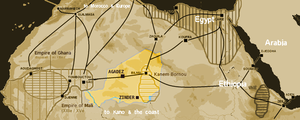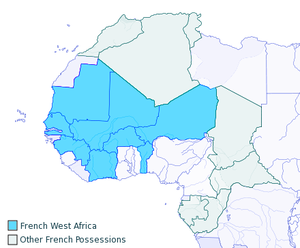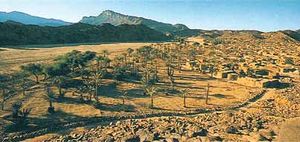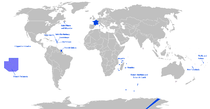تاريخ النيجر
جزء من سلسلة عن |
|---|
| تاريخ النيجر |
 |
| انظر أيضاً |
| السنوات في النيجر |

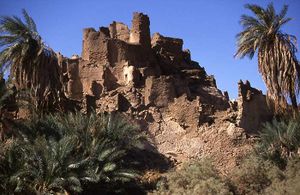
This is the history of Niger. See also the history of Africa and the history of West Africa.
. . . . . . . . . . . . . . . . . . . . . . . . . . . . . . . . . . . . . . . . . . . . . . . . . . . . . . . . . . . . . . . . . . . . . . . . . . . . . . . . . . . . . . . . . . . . . . . . . . . . . . . . . . . . . . . . . . . . . . . . . . . . . . . . . . . . . . . . . . . . . . . . . . . . . . . . . . . . . . . . . . . . . . . .
Pre-historic Niger
Humans have lived in what is now Niger from the earliest times. 2 to 3.5 million-year-old Australopithecus bahrelghazali remains have been found in neighboring Chad.
As the Sahara dried after 2000 BCE, the north of Niger became the desert it is today, with settlements and trade routes clinging to the Air in the north, the Kaouar and shore of Lake Chad in the west, and (apart for a scattering of oases) most people living along what is now the southern border with Nigeria and the southwest of the country.
The probable ancient regional ecology
North Africa enjoyed a fertile climate during the subpluvial era; what is now the Sahara supported a savanna type of ecosystem, with elephant, giraffe, and other grassland and woodland animals now typical of the Sahel region south of the desert. Historian and Africanist Roland Oliver has described the scene as follows:
[In] the highlands of the central Sahara beyond the Libyan desert,... in the great massifs of the Tibesti and the Hoggar, the mountaintops, today bare rock, were covered at this period with forests of oak and walnut, lime, alder and elm. The lower slopes, together with those of the supporting bastions — the Tassili and the Acacus to the north, Ennedi and Air to the south — carried olive, juniper and Aleppo pine. In the valleys, perennially flowing rivers teemed with fish and were bordered by seed-bearing grasslands.[1]
Metalworking technology
A 2002 UNESCO published study suggested that iron smelting at Termit, in eastern Niger may have begun as early as 1500 BC.[2] This finding, which would be of great importance to both the history of Niger and the history of the diffusion of Iron Age metalworking technology in all of sub-Saharan Africa, is as yet contentious.[3] Older accepted studies place the spread of both copper and Iron technology to date from the early first Millennium CE: 1500 years later than the Termit Massif finds.[4]
Ancient history
By at least the 5th century BCE, Carthage and Egypt became terminals for West African gold, ivory, and slaves trading salt, cloth, beads, and metal goods. With this trade, Niger was on the route between the empires of the Sahel and the empires of the Mediterranean basin.
Introduction of the camel
Herodotus wrote of the Garamantes hunting the Ethiopian Troglodytes with their chariots; this account was associated with depictions of horses drawing chariots in contemporary cave art in southern Morocco and the Fezzan, giving origin to a theory that the Garamantes, or some other Saran people, had created chariot routes to provide Rome and Carthage with gold and ivory. However, it has been argued that no horse skeletons have been found dating from this early period in the region, and chariots would have been unlikely vehicles for trading purposes due to their small capacity.[5]
Imperial Niger
Niger was an important economic crossroads, and the empires of Songhai, Mali, the Dendi Kingdom, Gao, and Kanem-Bornu, as well as a number of Hausa states, claimed control over portions of the area. During recent centuries, the nomadic Tuareg formed large confederations, pushed southward, and, siding with various Hausa states, clashed with the Fulani Empire of Sokoto, which had gained control of much of the Hausa territory in the late 18th century. The area eventually became known as the Bornu Empire, which ended in 1893.
بدأت هجرات قبائل الطوارق إلى ما يُسمى الآن بالنيجر في حوالي القرن الحادي عشر الميلادي. وقد كانت هذه القبائل تقيم في الأجزاء الوسطى من إقليم الصحارى وخلال فترة قصيرة تمكنت قبائل الطوارق من إحكام سيطرتها على كافة الطرق التجارية الممتدة مابين الصحراء وحتى الخط الساحلي جنوباً. وفي القرن الخامس عشر الميلادي، تمكنوا من إقامة إمبراطورية لهم، مركزها مدينة أغاديز. وفي نفس الوقت اشتد ساعد إمبراطورية صنغي خلال القرن الخامس عشر. وقد كانت عاصمتها مدينة غاو التي تقع ضمن حدود ما يعرف الآن بمالي. وفي القرن السادس عشر، غزت قبائل صنغي إمبراطورية الطوارق في عقرِ دارها (مدينة أغاديز)، وتمكنوا بذلك من السيطرة على أجزاء كبيرة من الأقاليم الوسطى والغربية لما يعرف الآن بالنيجر وفي عام 1591م، انطلقت جيوش من المغرب وسيطرت على مدينة گاو مما أدى إلى انهيار امبراطورية صنغي.
Colonization
In the 19th century, contact with Europe began when the first European explorers—notably Mungo Park (British) and Heinrich Barth (German)-explored the area searching for the mouth of the Niger River. Although French efforts at pacification began before 1900, dissident ethnic groups, especially the desert Tuareg, were not subdued until 1922, when Niger became a French colony.
وقد وصل الأوروبيون إلى النيجر وسيطرت فرنسا على أجزاء من غرب إفريقيا بناءً على اتفاقيات تم التوصل إليها بين القوى الأوروبية المختلفة خلال الفترة ما بين 1885-1890. وبحلول عام 1900، كانت فرنسا قد سيطرت على معظم أجزاء النيجر. وفي عام 1906، تمكنت فرنسا من إخماد حركة المقاومة العنيفة التي كانت تقودها قبائل الطوارق. وفي عام 1922، أصبحت النيجر جزءًا مما كان يعرف بغرب إفريقيا الفرنسية.
الاستقلال
وقد حصلت النيجر على استقلالها من فرنسا في الثالث من شهر أغسطس عام 1960. وعقب الاستقلال تمَّ انتخاب السيد هاماني ديوري ( زعيم الحزب التقدمي النيجيري) كأول رئيس للبلاد. ومنذ نهاية الستينيات وبداية السبعينيات تعرضت النيجر لموجات متلاحقة من الجفاف. وقد خلق هذا الوضع نقصاً حاداً وكبيراً في الأغذية، فضلاً عن مشكلات أخرى.
1974 to 1990
وفي عام 1974، قام انقلاب عسكري قاده ضابطٌ يدعى حسين كونتشي. وقد قضى هذا الانقلاب على فترة حكم السيد ديوري. وقام قادة الانقلاب بوقف العمل بالدستور وتم حل الجمعية الوطنية.
وقد ترأس كونتشي الحكومة حتى وفاته عام 1987. وإثر ذلك قام المجلس العسكري العالي باختيار العقيد علي سايبو (شعيب) خلفاً لكونتشي رئيسًا للمجلس.
وخلال الثمانينيات من القرن العشرين عانى اقتصاد النيجر كثيرًا بسبب التدهور الكثير الذي طرأ على أسعار اليورانيوم في العالم. وفي عام 1989 تمت المصادقة على مسودة دستور البلاد.
وبمقتضى الدستور أُجريت انتخابات عامة في ديسمبر 1989. وتم انتخاب سايبو رئيساً للبلاد. كما أقر الدستور الجديد إنشاء جمعية وطنية جديدة.
1990s
اختارت الحكومة النظام السياسي التعددي عام 1992، وأجريت انتخابات عامة في العام التالي فاز فيها مهمان (محمد) عثمان ممثل اتئلاف اتحاد قوى التغيير وتم تنصيبه رئيسًا للبلاد. أطاح انقلاب عسكري قاده الكولونيل إبراهيم باري مناصرة بحكومة عثمان الذي اعتقل وأعضاء حكومته عام 1996. ونصَّب مناصرة نفسه رئيسًا للبلاد. وفي مايو من السنة نفسها أقرت دولة النيجر دستوراً جديداً، وفي يوليو فاز الرئيس مناصرة في الانتخابات الرئاسية وسط إدعاءات زعماء المعارضة بأن الحكومة عملت على تزوير هذه الانتخابات، ودعت المعارضة إلى إلغاء نتائجها. وفي أبريل عام 1999، نصب جنود كميناً للرئيس مناصرة في مطار نيامي وقتلوه.
2000s
Second Tuareg insurgency in Niger began in 2007 when a previously unknown group, the Mouvement des Nigeriens pour la Justice (MNJ), emerged. The predominantly Tuareg group issued a number of demands, mainly related to development in the north. It attacked military and other facilities and laid landmines in the north. The resulting insecurity devastated Niger's tourist industry and deterred investment in mining and oil. Algeria helped negotiate an August 2008 Malian peace deal, which was broken by a rebel faction in December, crushed by the Malian military and wholesale defections of rebels to the government. Niger saw heavy fighting and disruption of Uranium production in the mountainous north, before a Libyan backed peace deal, aided by a factional split among the rebels, brought a negotiated ceasefire and amnesty in May 2009.
On 26 May 2009, President Tandja dissolved parliament after the country's constitutional court ruled against plans to hold a referendum on whether to allow him a third term in office. According to the constitution, a new parliament was elected within three months.[6] This touched off a political struggle between Tandja, trying to extend his term-limited authority beyond 2009 through the establishment of a Sixth Republic, and his opponents who demanded that he step down at the end of his second term in December 2009. See 2009 Nigerien constitutional crisis. The military took over the country and President Tandja was put in prison, charged with corruption.
The military kept their promise to return the country to democratic civilian rule. A constitutional referendum and national elections were held. A presidential election was held on 31 January 2011, but as no clear winner emerged, run-off elections were held on 12 March 2011. Mahamadou Issoufou of the Nigerien Party for Democracy and Socialism was elected president. A parliamentary election was held at the same time.[7][8][9]
. . . . . . . . . . . . . . . . . . . . . . . . . . . . . . . . . . . . . . . . . . . . . . . . . . . . . . . . . . . . . . . . . . . . . . . . . . . . . . . . . . . . . . . . . . . . . . . . . . . . . . . . . . . . . . . . . . . . . . . . . . . . . . . . . . . . . . . . . . . . . . . . . . . . . . . . . . . . . . . . . . . . . . . .
See also
- Niamey history and timeline (capital and largest city)
- History of Africa
- History of West Africa
- List of heads of government of Niger
- List of heads of state of Niger
- Politics of Niger
- Green Sahara
References
- ^ Oliver, Roland (1999), The African Experience: From Olduvai Gorge to the 21st Century (Series: History of Civilization), London: Phoenix Press, revised edition, pg 39.
- ^ Iron in Africa: Revisiting the History Archived 25 أكتوبر 2008 at the Wayback Machine – Unesco (2002)
- ^ خطأ استشهاد: وسم
<ref>غير صحيح؛ لا نص تم توفيره للمراجع المسماةHaour2003 - ^ Duncan E. Miller and N.J. Van Der Merwe, 'Early Metal Working in Sub Saharan Africa' Journal of African History 35 (1994) 1–36; Minze Stuiver and N.J. Van Der Merwe, 'Radiocarbon Chronology of the Iron Age in Sub-Saharan Africa' Current Anthropology 1968.
- ^ Masonen, P: "Trans-Saharan Trade and the West African Discovery of the Mediterranean World. Archived 8 أكتوبر 2006 at the Wayback Machine"
- ^ "Africa – Niger leader dissolves parliament". Al Jazeera English. 26 مايو 2009. Archived from the original on 7 فبراير 2011. Retrieved 3 مايو 2010.
- ^ Ahmad, Romoke W. "West Africa: Ecowas, EU Say Niger Elections Satisfactory" Archived 29 يونيو 2011 at the Wayback Machine, Daily Trust (republished at AllAfrica.com), 3 February 2011.
- ^ Saidou, Djibril. Niger’s Presidential Election Heads to March Runoff" Archived 28 يونيو 2011 at the Wayback Machine, Bloomberg Businessweek, 4 February 2011.
- ^ Look, Anne. "Niger Politicians Forge Alliances Before March Election" Archived 7 فبراير 2012 at the Wayback Machine, Voice of America, 14 February 2011.
- James Decalo. Historical Dictionary of Niger. Scarecrow Press/ Metuchen. NJ – London (1979) ISBN 0-8108-1229-0
- Finn Fuglestad. A History of Niger: 1850–1960. Cambridge University Press (1983) ISBN 0-521-25268-7
Further reading
- Chafer, Tony. The End of Empire in French West Africa: France's Successful Decolonization. Berg (2002). ISBN 1-85973-557-6
External links
- Background Note: Niger
- Lydia Samarbakhsh-Liberge (ed.). "Chronologie: Niger". Histoire-afrique.org (in الفرنسية). Archived from the original on 14 نوفمبر 2007. Initiated by Agence universitaire de la Francophonie



